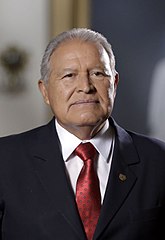Salvador Sánchez Cerén
 | |
| Data i miejsce urodzenia | 18 czerwca 1944 Quezaltepeque |
|---|---|
| Prezydent Salwadoru | |
| Okres | od 1 czerwca 2014 do 1 czerwca 2019 |
| Przynależność polityczna | Front Wyzwolenia Narodowego im. Farabunda Martíego |
| Poprzednik | Mauricio Funes |
| Następca | Nayib Bukele |
 | |
Salvador Sánchez Céren (ur. 18 czerwca 1944 w Quezaltepeque[1]) – salwadorski polityk, prezydent od 1 czerwca 2014 do 1 czerwca 2019.
W okresie wojny domowej w latach 1980–1992 był komendantem FMLN. 1 czerwca 2009 został zaprzysiężony na wiceprezydenta, podczas kadencji Mauricio Funesa. Był także ministrem edukacji[2]. 2 lutego 2014 w pierwszej turze wyborów prezydenckich zdobył 48,93% głosów i awansował do drugiej tury, w której pokonał Normana Quijano z Narodowego Sojuszu Republikańskiego[3].
Przypisy
- ↑ Salvador Sánchez Cerén, Vicepresidente de la República 2009–2014, Presidencia de la República de El Salvador [dostęp 2014-03-19] [zarchiwizowane z adresu 2010-12-20] (hiszp.).
- ↑ Leftist ex-guerrilla Sanchez Ceren finally declared El Salvador president, Deutsche Welle, 17 marca 2014 [dostęp 2014-03-19] (ang.).
- ↑ Salwador. Były partyzant Sanchez Ceren zwycięzcą wyborów prezydenckich, Wyborcza.pl, 13 marca 2014 [dostęp 2014-03-19] [zarchiwizowane z adresu 2014-03-19].
Media użyte na tej stronie
Autor: Presidencia El Salvador from San Salvador, El Salvador, América Central, Licencja: CC0
Cadena 12
Coat of arms of El Salvador
- The coat of arms has the words (REPÚBLICA DE EL SALVADOR EN LA AMÉRICA CENTRAL) in a bold and Heavy, Sans Serif Boris Black Bloxx typeface, in a golden amber color
- The nacional motto (DIOS UNIÓN LIBERTAD) in bold version of Trajan (typeface), Roman type, Roman square capitals. The letters are colored black within a golden amber scroll.
- The date (15 DE SEPTIEMBRE DE 1821) in bold version of Trajan (typeface), Roman type, Roman square capitals.



